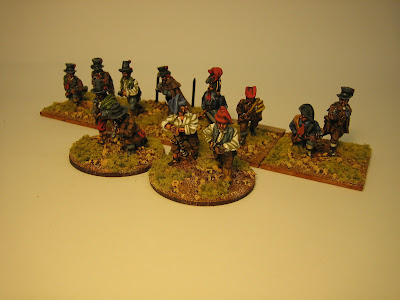Okay, so first I must tell you that you are seeing these units out of painting sequence. I had painted 1st Asturias before these with plans for 2nd Asturias (which I will show you together) but, 1st Asturias brought me to twelve units of infantry and I wanted to skip the number between twelve and fourteen by painting two small units of Guerrillas together - this army will never have thirteen units of anything, and none of my previous armies have either. Actually, I'm not superstitious. I'll happily travel on a number thirteen bus or stay in a room thirteen (though there are very few of the latter as hoteliers know that some people will want to be moved: Hotels have a 12A or 14A, or more commonly skip 13 completely): For me, skipping thirteen is more of a quirky tradition than anything else, probably acquired whilst working in small hotels.
Anyway, hotel trivia done with, onward and upward. Two units of guerrillas and another command stand. No Spanish army is complete without a couple of guerrilla units, IMHO.
Guerrilla unit 1.
All these figures are
Front Rank straight out of the box, except I changed the arm position of one which I had intended to use on the command stand below, but didn't (see unit 2's leader in the green jacket).
After following my usual practice of painting the hands and faces first, I painted all the base colours for the clothes before moving onto the shading. Usually I do each colour with shading before moving onto the next colour.
This is the best way to achieve the balance of colours you want in irregular units because you can change the balance quickly, if you need to, before doing all the shading work.
Guerrillas 2.
The key colour for guerrillas is brown so I painted that colour first, making sure I painted a lot of it. Then I added the other colours.
One decision I made early was that all shirts would be white: To my mind nothing, at distance, gives the look of 'in shirt sleeves' better. Coloured shirts can often look like jackets.
Then I painted all the leather bits, muskets, sandals, etc. Finishing with metals.
My painting style is quite 'bright' so I had to make a real effort to tone these figures down a bit. Even 'toning down' I think these figures still 'pop' - apparently, I can't help myself.
I have based my guerrillas as small bands in extended line (as per units like the 95th) with two extra skirmish stands per unit.
At the scale I usually play each unit would represent a large band of several hundred so I can't see them featuring in historic battles much but, they will be useful for smaller scenarios and to add flavour to larger fictitious battles.
BAD JOKE ALERT! Is it possible to play a Spanish Napoleonic battle without a very big cannon and Frank Sinatra doing it Cary Grant's way? Sadly, Sophia doesn't feature in either of my guerrilla bands and, before you bring it up, I know there was a joke in there somewhere about having Sophia Loren on a table.
Divisional command stand number 5.
When I made up
my C-in-C stand I had intended to use a much smaller, less complex, table set up and I even made a small trestle table out of birch wood (ice lolly stick) for it. It's simply a single 'plank' of birch bevelled on the underside edges, to make it look thinner, with a birch 'X' trestle leg arrangement.
Top tip: Ice lolly sticks, most commonly made from birch wood, are great for making tables, five bar gates, etc. Much stronger than balsa wood, and free with ever lolly.
Well, that table had to go somewhere and here it is.
Figures by Front Rank and feature the guerrilla leader without a modified arm: His extended arm serves to protect the (more fragile) table when the stand is being picked up. The table is actually pretty solid but, clumsy fingers, etc.
The table features a partly rolled up map and some sheets of paper (for orders to be written on). These are paper.
The rolled map is being held open with a book (a small block of wood painted to look like a closed book).
The sheets of paper are 'paper-weighted' by a large silver, silver lidded inkpot with a quill in it (the pot and lid are a couple of pieces of white metal, cut from a very thick spear shaft casting, superglued together; the quill is a pin and cut down 'feather plume' from a Steel Fist Italian Wars head - pot and feather have been drilled and connected together by the pin which serves as the quill).
Next up, my 1st and 2nd Asturias.







3 comments:
I'm really enjoying these Napoleonic posts of yours, so much so that I've just gorn and bought some Front Rank Napoleonics...
No need to be 'humble', guerrillas are an absolute must!
I already have a giant, plastic Warhammer painted up and awaiting Cary, Frank and Sophia.
As my Spanish are 20mm the cannon looks pretty impressive while still falling somewhat short of the unbelievable monstrosity from the film; that was probably also plastic (glass-fibre?) judging from the way it bobbled about when on the move.
In CS Forester's book it's only an 18pdr and the real gun that inspired his story was only a 12pdr! That's inflation for you.
Another vote that Guerillas are a must for a Spanish Napoleonic army. Small numbers did indeed appear on actual battlefields (Fuentes de Onoro comes readily to mind), and they are priceless for raid, ambush, wagon Train, and other Petite Guerre scenarios1
Post a Comment